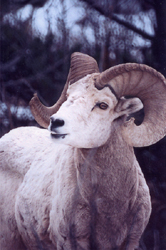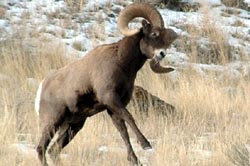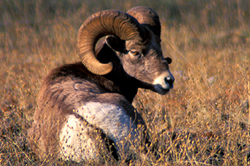Bighorn Sheep
Updated: August 7, 2020

Bighorn sheep's scientific name Ovis canadensis. A quick question about the obvious: how did bighorn sheep get their name? That's right, because they have big horns. In fact the males, which are called rams, are known for their massive curled horn; the older the male, the more length and "curl" the horns will have. These horns continue to grow throughout their life. The age of a ram can be counted from the growth rings of its horns. Female bighorn sheep, called ewes, also have horns but theirs are much smaller. A ramís horns can weigh as much as 30 pounds.
Bighorn sheep are right at home in Montana's rugged mountains. Their gray-brown coats help them to blend into the mountainside. Bighorn sheep are sure-footed animals that have a rough pad on the bottom of their two-toed, spread-out hooves; they move well on rough, uneven ground. Their hooves are hard on the outside and soft on the inside, making them excellent climbers and jumpers. As herbivores (plant-eaters), bighorn sheep spend most of the day grazing in the high mountain ranges. They eat grass, leaves, herbs, twigs and shoots. Sheep swallow their food without chewing it much. Later they regurgitate the food and chew it thoroughly before swallowing it again.

The males literally become battering rams as they face off in duels, battering their horns together in violent collisions. Such head-to-head combat establishes dominance. They charge each other at speeds of more than 20 miles per hour, their foreheads crashing with a crack that can be heard more than a mile away. These head-jarring battles can last all day! Thankfully they have special cushioned skulls to help absorb the shock. This battling happens during the breeding season or rut. The dominamt ram will be the one the ewes will mate.
Ewes usually have one lamb born between April and late June. Lambing areas are on the most inaccessible cliffs. Lambs are woolly and white and have little horns, and weigh from 8 to 10 pounds at birth and grow to 70 - 90 pounds at 8 - 10 months of age. The lamb can stand and climb shortly after birth but will stay hidden where it was born for about a week and then it will start to follow its mother. It will be fed milk until it is about five months old. Male lambs will leave their mother and join a male group when they are between two and four years old. Female lambs will usually remain with their mothers' group their whole life.

Of all the big game species, bighorn sheep are among the most social. Bighorn sheep live in herds or bands, usually of about 5 to 15 animals, including ewes, lambs, yearlings and two-year-olds; the dominant ewe is the leader. Ram bands usually consist of two to five rams. In winter ewe herds join together and there may be as many as 100 animals all led by one old ewe. In the autumn they are joined by the mature rams in time for the mating season. Bighorn sheep often are seen climbing rocky slopes to evade predators. Their chief predator is the cougar.Sometimes when a group of bighorn sheep is threatened by a predator such as a wolf, the bighorn sheep will group together in a circle and face out towards the predator.
Thanks for visiting the Montana Kids' Site! We hope you've found the information both educational and entertaining. If you have comments or suggestions on ways we can improve the site please send us email at montanakids@visitmt.com.
You can also help your family plan a trip to Montana. Have your folks request a statewide travel packet by clicking here.

